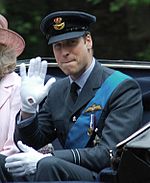Flight lieutenant
| Flight lieutenant | |
|---|---|
 Shoulder and sleeve insignia of a flight lieutenant from the Royal Air Force | |
| Service branch | Air forces |
| Abbreviation | Flt Lt / FLTLT |
| NATO rank code | OF-2 |
| Non-NATO rank | O-3 |
| Formation | 1 August 1919 (RAF) |
| Next higher rank | Squadron leader |
| Next lower rank | Flying officer |
| Equivalent ranks |
|
| Related articles | |
| History | Royal Naval Air Service |
Flight lieutenant is a junior commissioned rank in air forces that use the Royal Air Force (RAF) system of ranks, especially in Commonwealth countries. It has a NATO rank code of OF-2. Flight lieutenant is abbreviated as Flt Lt in the Indian Air Force (IAF) and RAF, and as FLTLT in the Pakistan Air Force (PAF), Royal Australian Air Force (RAAF) and Royal New Zealand Air Force (RNZAF) and has sometimes also been abbreviated as F/L in many services; however, it has never been correctly abbreviated as "lieutenant". A flight lieutenant ranks above flying officer and below a squadron leader and is sometimes used as an English language translation of a similar rank in non-English-speaking countries.
The rank originated in the Royal Naval Air Service (RNAS) in 1914. It fell into abeyance when the RNAS merged with the Royal Flying Corps during the First World War but was revived in 1919 in the post-war RAF.
An RAF flight lieutenant is the equivalent of a lieutenant in the Royal Navy and a captain in the British Army and Royal Marines. The equivalent rank in the former Women's Auxiliary Air Force (WAAF), Women's Royal Air Force (WRAF) and Princess Mary's Royal Air Force Nursing Service (PMRAFNS) (until 1980) was flight officer.
Origins[]

The rank originated in the Royal Navy as a rank title for naval lieutenants serving in the Royal Naval Air Service (RNAS).[1] Promotions to the rank were first gazetted on 30 June 1914.[2] It fell into abeyance when the RNAS merged with the Royal Flying Corps during the First World War but was revived in 1919 in the post-war RAF.[3]
On 1 April 1918, the newly created RAF adopted its officer rank titles from the British Army, with Royal Naval Air Service lieutenants (titled as flight lieutenants and flight commanders) and Royal Flying Corps captains becoming captains in the RAF. In response to the proposal that the RAF should use its own rank titles, it was suggested that the RAF might use the Royal Navy's officer ranks, with the word "air" inserted before the naval rank title. For example, the current rank of flight lieutenant would have been "air lieutenant". Although the Admiralty objected to this simple modification of their rank titles, it was agreed that the RAF might base many of its officer rank titles on navy officer ranks with differing pre-modifying terms. It was also suggested that RAF captains might be entitled flight-leaders. However, the rank title flight lieutenant was chosen as flights were typically commanded by RAF captains and the term flight lieutenant had been used in the Royal Naval Air Service. The rank of flight lieutenant has been used continuously since 1 August 1919.
Usage in the RAF[]
Royal Air Force
Although in the early years of the RAF a flight lieutenant commanded an aircraft flight, with the increasing combat power of aircraft and therefore squadrons, command and control has shifted up the rank structure (currently, for instance, most squadron commanders in the RAF are Wing Commanders, a reflection on the comparative combat power between the modern air force and its predecessor).
The RAF's promotion system is automatic up until Flight Lieutenant. Every officer will attain the rank provided they complete their professional training and do not leave early. For Aircrew, Flight Lieutenant is reached 2.5 years after commissioning, Engineering Branch (AS & CE) entrants with applicable Bachelors/Masters degrees reach Fight Lieutenant at 2.5 and 1.5 years respectively, and for all other ground branch officers, 3.5 years. Aircrew are appointed to an Early Departure Payment Commission upon reaching their Operational Conversion Unit, which is a commission for 20 years or age 40, whichever is later. Promotion to Squadron Leader thereafter is strictly upon merit; officers promoted beyond Flight Lieutenant are appointed to a Career Commission, or service to age 60. Resigning a commission is generally dependent on the needs of the Service, although an officer who has completed their Return of Service (service the RAF requires to justify its expense in originally training the officer) could leave after as little as four years. For aircrew, given the large expense required for training, this Return of Service is generally the length of their initial commission anyway, unless they re-role to a different branch having failed an element of flying training. Most aircrew reach their squadrons as Flight Lieutenants due to the length of training time required (up to four years for fast jet pilots) and the significant holds in the training pipeline.[4] The majority of squadron line pilots are flight lieutenants, with some squadron executives or Career Commission aircrew reaching Squadron Leader.
Aside from aircrew, whose work typically does not require active leadership for units of airmen, ground branch officers can expect to operate units that can range in size from a few specialist non-commissioned personnel to 50 or more personnel for engineering or other manpower intensive roles. The role of a Flight Lieutenant generally involves management of a team of specialists Non-Commissioned Officers and airmen, within their specific branch. In the RAF Regiment, a Flight Lieutenant generally has the same role and responsibility as a Captain in the British Army, in charge of a Regiment Flight of 30 men, and could be second-in-command of a Squadron of up to 120 men.
Flight Lieutenant is the most common officer rank in the RAF; in April 2013, for example, there were 8,230 RAF officers, of whom 3,890 (47.3%) were Flight Lieutenants.[5] In RAF informal usage, a flight lieutenant is sometimes referred to as a "flight lieuy". A Flight Lieutenant's starting salary is £42,008.48 as of 2019.[6]
RAF Air Cadets
In the Air Training Corps, a flight lieutenant is usually the officer commanding of a squadron[citation needed], appointed under a Cadet Forces Commission.[7] Retired flight lieutenants are the first rank that may continue to use their rank after they have left active service.[8]
Insignia[]
The rank insignia consists of two narrow blue bands on slightly wider black bands. This is worn on both the lower sleeves of the tunic or on the shoulders of the flight suit or the casual uniform. The rank insignia on the mess uniform is similar to the naval pattern, being two band of gold running around each cuff but without the Royal Navy's loop. Unlike senior RAF officers, flight lieutenants are not entitled to fly a command flag under any circumstances.

An RAF flight lieutenant's sleeve/shoulder insignia

An RAF flight lieutenant's sleeve mess insignia

An RAF flight lieutenant's sleeve on No. 1 service dress uniform
Other air forces[]
The rank of flight lieutenant is also used in a number of the air forces in the Commonwealth, including the Bangladesh Air Force,[9] Ghana Air Force, Indian Air Force,[10] Namibian Air Force, Pakistan Air Force, Royal Australian Air Force and Royal New Zealand Air Force. It is also used in the Egyptian Air Force, Hellenic Air Force, Royal Air Force of Oman, Royal Thai Air Force and the Air Force of Zimbabwe.[11]
The Royal Canadian Air Force used the rank until 1968, when the three armed services were unified and army-type ranks were adopted; flight lieutenants became captains. In official French Canadian usage, a flight lieutenant's rank title was capitaine d'aviation. Until the late 1970s, the Royal Malaysian Air Force used the rank. Thereafter the rank of captain was used instead.
In the Danish Army, a flight lieutenant is called a captain (Army equivalent). The rank of flight lieutenant is an old Army rank for army pilots and is now used for lieutenants (OF-1).

An RAAF flight lieutenant's sleeve/shoulder insignia

A RNZAF flight lieutenant's sleeve/shoulder insignia

A Hellenic Air Force sminagos (flight lieutenant's) rank insignia

An Indian Air Force flight lieutenant's rank insignia

A Namibian Air Force flight lieutenant's rank insignia

A PAF flight-lieutenant's rank insignia.

A RTAF flight lieutenant's rank insignia
Notable flight lieutenants[]


- Alexander, Prince of Yugoslavia – member of Yugoslavian royal family
- Gerald Bouey – former governor of the Bank of Canada
- Sir Arthur C. Clarke – British author and inventor
- Sir Christopher Lee – British actor, served in RAF Intelligence during World War II
- Peter Francis Middleton – grandfather of Catherine, Duchess of Cambridge and co-pilot of Prince Philip
- Sir Patrick Moore – British astronomer
- Donald Pleasence – British actor
- Matiur Rahman – Bangladesh Air Force () pilot; honoured in Bangladesh with highest military honour for his heroic attempt to defect at the start of the Bangladesh Liberation War in 1971.
- Jerry Rawlings – Ghanaian politician who twice served as his country's president
- Ian Smith – Prime Minister of Rhodesia (1964–1979)
- Rory Underwood – Leicester, England and British and Irish Lions winger[12]
- Jim Vipond – Canadian sports columnist
- Gough Whitlam – Prime Minister of Australia (1972–1975)
- John Nichol – Former RAF Navigator, Gulf War prisoner of war and motivational speaker.
See also[]
- Air force officer rank insignia
- British and U.S. military ranks compared
- Comparative military ranks
- RAF officer ranks
- Ranks of the RAAF
- Lieutenant (for pronunciation)
References[]
- ^ Spooner, Stanley, ed. (26 June 1914). "Royal Naval Air Service Reorganisation". Flight. VI (287): 686. Retrieved 27 June 2021.
- ^ "No. 28845". The London Gazette. 30 June 1914. p. 5070.
- ^ "Ranks and Badges of the RAF". Royal Air Force. 2015. Archived from the original on 2 July 2008. Retrieved 22 March 2015.
- ^ (PDF) https://www.nao.org.uk/wp-content/uploads/2015/06/Military-Flying-Training.pdf. Missing or empty
|title=(help) - ^ "UK Armed Forces Annual Personnel Report" (PDF). Ministry of Defence. 1 April 2013. Retrieved 22 March 2015.
- ^ (PDF) https://www.raf-ff.org.uk/wp-content/uploads/2019/09/20190919-2019-Pay-Rates.pdf. Missing or empty
|title=(help) - ^ (PDF) https://assets.publishing.service.gov.uk/government/uploads/system/uploads/attachment_data/file/758400/00149.pdf. Missing or empty
|title=(help) - ^ "Armed Forces, Forms Of Address". Debrett's. 2015. Archived from the original on 13 September 2012. Retrieved 22 March 2015.
- ^ "BAF RANKS". Bangladesh Air Force Website. BAF Communication Unit. 2020. Retrieved 13 December 2020.
- ^ "Officer ranks in Indian Army, Air Force and Navy". India Today. New Delhi. 25 February 2019. Retrieved 19 December 2020.
- ^ "RANKS AND BADGES IN THE AFZ". Air Force of Zimbabwe Website. Air Force of Zimbabwe. 2020. Retrieved 13 December 2020.
- ^ "No. 58941". The London Gazette (Supplement). 6 January 2009. p. 123.
| show |
|---|
- Military ranks of the Commonwealth
- Military ranks of Australia
- Former military ranks of Canada
- Military ranks of the Royal Air Force
- Air force ranks
- Military ranks of Pakistan
- Military ranks of Bangladesh
- Military ranks of Sri Lanka
- Military ranks of the Indian Air Force







